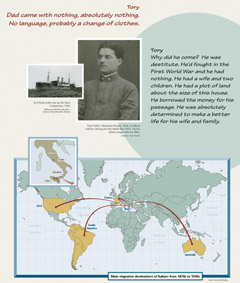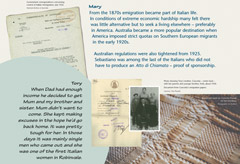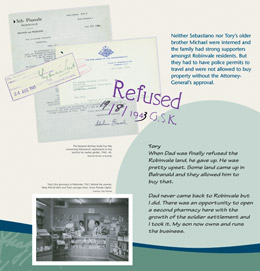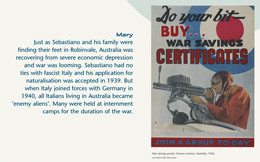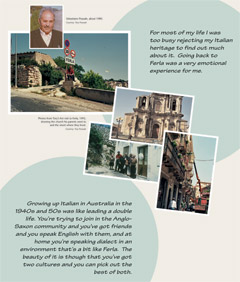| Robinvale perspectives |
Tory Pisasale: A second generation perspective
From Italy 1925 to Robinvale 1936
One of the main aspects of Tory’s story was the experience of Italians in Australia during the period of the Second World War when Australia and Italy were enemies. Another was the tension between traditional values and the Australian lifestyle which is felt by many second generation migrants.
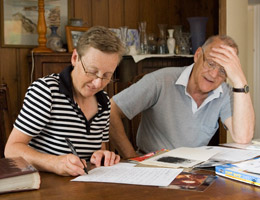 Tory speaking with Mary. Photograph: Jo Sheldrick, 2007. Tory speaking with Mary. Photograph: Jo Sheldrick, 2007. |
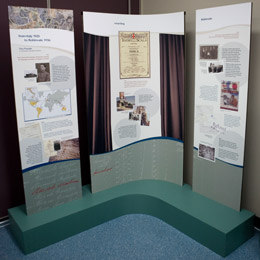 |
|
| View of Tory ’s story on display at the Robinvale exhibition. Photograph: Jo Sheldrick, 2007. |
Mapping the personal, the local and historical
| Detail from Tory Pisasale, panel one, Migration Memories: Robinvale. Design: Paula McKindlay. |
Italians have been coming to Australia in significant numbers since the late nineteenth century when poverty drove many to emigrate. In the exhibition, maps, text and images showed the 1920s context in which Tory’s father, Sebastiano, arrived in Melbourne. At this time the favoured destination, America, had imposed a quota on Italian migrants and Australia hadn’t yet finalised more stringent sponsorship regulations.
A typical pattern of Italian emigration was for men to leave first, followed by other family members. In this way clusters of settlement from particular villages and regions developed. Sebastiano was the first to go to Australia from his village in Sicily.
| Detail from Tory Pisasale, panel one, Migration Memories: Robinvale. Design: Paula McKindlay. |
The local
Tory’s family arrived to set up a market garden in Robinvale in 1936. At the same time hostilities between Australia and Mussolini’s fascist Italy were increasing. Sebastiano was naturalised as an Australian citizen in 1939 but his rights as a citizen were severely curtailed during the War. A particular disappointment was that he was refused the right to buy land in Robinvale.
| Details from Tory Pisasale, panel three, Migration Memories: Robinvale. Design: Paula McKindlay. | ||
The personal in historical context
Tory describes the tension between being both Italian and Australian as ‘leading a double life’. In his younger years he resolved this by rejecting the Italian side. In his later years he has reconnected with his parents’ world and sees himself as part of both.
| Detail from Tory Pisasale, panel two, Migration Memories: Robinvale. Design: Paula McKindlay. |
Looking back on the project
Tory:
I didn’t realise at the time, you know, years gone by, that in a sense Dad was part of history and part of Italian history and part of Australian history too. And you don’t look at it that way. But looking at it now, looking at the exhibition there, not only Dad but all the others, that’s our Australian history… It’s not just convicts, it’s not just ANZAC, but the migrants that made the country and the offshoots from the migrants… I think it [the exhibition] is terrific and it should make people think anyway and I suppose that’s the ultimate aim of the thing, to make people think about migration and not have closed minds about it.
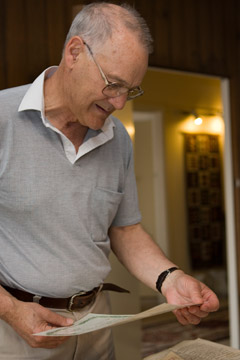 |
|
| Tory Pisasale. Photograph: Jo Sheldrick, 2006. |
Mary:
As well as reflecting on his own experience of rejecting and ‘returning’ to his Italian heritage, Tory had thought a lot about what it must have been like for his parents. We focused on Tory’s father in the exhibition. His mother was an equally strong character but her experience was distinctively that of a woman, and while sensitive to it, Tory was not so connected with it. When I talked with Tory’s sisters, Nella and Grace, at the exhibition, I also became aware of how different their experience as second generation women was from Tory’s. If I’d worked with one of them, the story would have taken a quite different direction.

